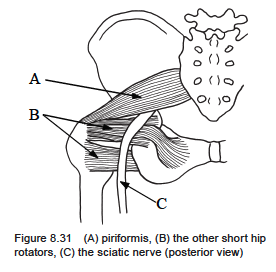What Are Trigger Points?
Trigger points are irritable contraction knots in muscles that can cause a ton of pain throughout the body. Trigger points have been linked to back pain, neck pain, headaches, sciatica, and many other health issues [1].
Trigger points cause constant muscle tension in the muscles they inhabit, meaning the trigger point muscle is constantly pulling on the joints it is attached to [1]. This can cause pain and may cause stretching to a full range of motion to be difficult. Trigger points can be sensitive/irritable to the touch - a good sign you worked out a trigger point in a muscle is that higher pressure feels less painful than a lower level of pressure initially.

Trigger Point Visual [1]: The black dots symbolize trigger point locations. The taut band is the group of muscle fibers under constant tension.
If trigger points are so important, why hasn't my doctor told me about them?
As the great trigger point therapy pioneer David Simons beautifully quoted: "Muscle is an orphan organ. No medical specialty claims it. As a consequence, no medical specialty is concerned with promoting funded research into the muscular causes of pain, and medical students and physical therapists rarely receive adequate primary training in how to recognize and treat myofascial trigger points" [2]. You've heard of a heart doctor, a foot doctor, and a brain doctor, but never a muscle doctor. Trigger point therapy content is not a standard medical curriculum, it must be sought out. Very few professionals take this step to learn the category of trigger point therapy.
I think some of my muscles have trigger points, how do I know where they are?
This question brings in the topic of referred pain - it is a mistake to assume the trigger point is in the place that hurts. For example, low back pain can be caused by trigger points in the QL muscle (in the low back region), the Psoas muscle (a hip flexor in the front of the body), or the Gluteus Medius (an upper butt muscle). Trigger point examination and elimination is a discipline in itself. For self-treatment, I would recommend learning from a book such as The Trigger Point Therapy Workbook by Clair and Amber Davies. This book is user-friendly and guides the reader easily through diagnosing their pain.
How to massage Sciatica trigger points?
Sciatica trigger points are often caused by the Piriformis and Gluteus Minimus muscles. Both muscles can compress on the sciatic nerve when they get tight, and relief comes from massaging and stretching the area to loosen the muscles off the sciatic nerve.

Sciatic Nerve (C) Compressed By Piriformis (A) [1]
These links show you exactly how to massage sciatica trigger points in the Piriformis and Gluteus Minimus muscles at the source of sciatica:
My lower back hurts and I think it is caused by trigger points, what should I do?
There is actually a device and accompanying tutorials for this exact issue - the QL Claw trigger point release device. QL Claw was designed to release trigger points in the 5 main muscles that contribute to low back pain - Quadratus Lumborum (QL), Psoas, Iliacus, Gluteus Medius, and Piriformis. QL Claw has videos and written tutorials on how to release these muscles to get out of pain.
Sources:
[1] Davies, Clair, and Amber Davies. The Trigger Point Therapy Workbook: Your Self-Treatment Guide for Pain Relief. 3rd ed., New Harbinger Publications, Inc., 2013.
[2] Donnelly, Joseph M. Travell, Simons & Simons Myofascial Pain and Dysfunction: the Trigger Point Manual. 3rd ed., Wolters Kluwer Health, 2019.


